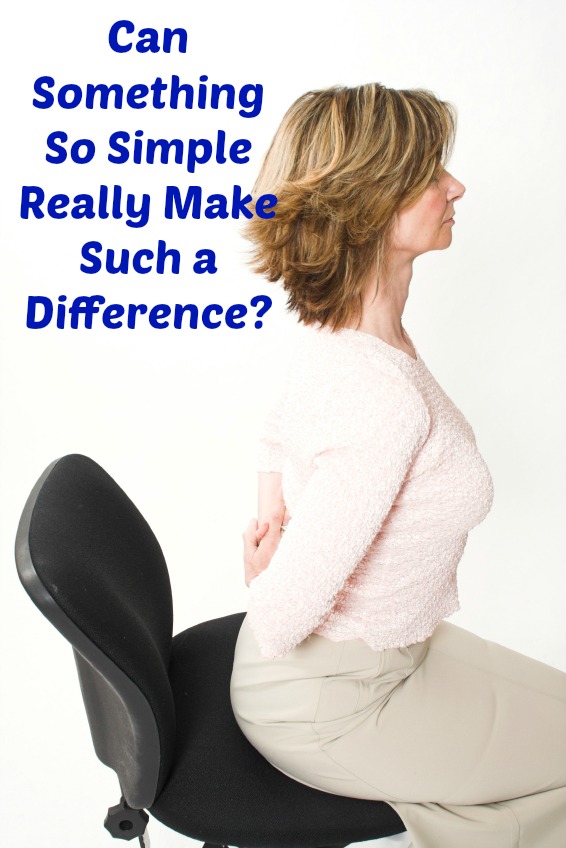When we think about mindful change, or any change, we think about how much work it’ll take to change and how hard it is. But not all change is complex. Sometimes it’s really simple.
Today is one of those times.
 Tweak how you sit and stand, and you’ll change your life. I know that sounds a bit drastic, but it’s still true.
Tweak how you sit and stand, and you’ll change your life. I know that sounds a bit drastic, but it’s still true.
Good posture lets you breathe better, gives you more energy, prevents injuries, makes you look successful and confident, makes you feel more successful and confident, lets you digest your food more easily, and prevents common aches and pains. Bad posture does the opposite.
And let’s face it. In the scheme of things you want to change about yourself and your life, there aren’t many things on your list that are easier to change than posture.
I’ve asked a friend of mine, Dr. Kathryn Woodall, to gives us all some tips for sitting and standing. Here’s what she recommended:
Seated
Getting your workstation ergonomics right plays a huge role in staying healthy over the long term. Here are some tips on how to set yourself up for success:
- Make sure your feet rest flat on the floor.
- Your knees should be bent at a 90-degree angle, or slightly more.
- The majority of your weight rests on your “sits bones”.
- An imaginary line drawn up the side of your body runs perpendicular to the floor, through your hip, shoulder, and the hole in your ear. Take a picture to see how close you are to this ideal.
- Sit tall in your chair with your shoulders back. Your head sits directly between your shoulders rather than sliding forward to sit over your lap. Mutant ninja turtles are cool, but desk jockey turtles are just geeks with bad posture.
- Elbows rest close to your sides, bent at or slightly greater than 90 degrees.
If you’re at a keyboard,
- Your hands should rest comfortably on your keyboard—similar to the angle they’d be in if you were resting them on your legs.
- Hold your wrists neutral or bent back 15 to 20 degrees. The same advice holds true when using a mouse. Avoid reaching far to the front or off to the side for a mouse—it puts needless stress on your shoulder and neck. If your elbow can’t remain at your side, your mouse is too far away.
- The top of your computer monitor is level with your eyebrows, and the screen sits directly in front of you.
- Set your chair at a height that allows all of the above to line up.
Standing
Many of the same principles from seated posture apply to those who stand all day, too:
- Make sure your feet rest flat on the floor. Don’t roll them to the inside or outside. If possible, don’t wear heels. If you have to wear heels, stretch your calves throughout the day.
- Avoid locking your knees or hyperextending them. From the side, the middle of your knee should line up with your outside ankle bone.
- The majority of your weight rests mid-foot. Technically it also rests on your pelvis, but if you work to align your body properly, that will automatically happen.
- An imaginary line drawn up the side of your body runs perpendicular to the floor, through your outer ankle bone, mid-knee, mid-hip, mid-shoulder, and the hole in your ear. Take a picture to see how close you are to this ideal.
- Stand tall. Your head should sit directly between your shoulders rather than sliding forward. Imagine that the crown of your head reaching for the ceiling. You want a slight curve in the back of your neck. Your goal isn’t to get rid of the curve, it’s to stand tall and keep your head balanced between your shoulders.
- Keep your shoulders back, chest up, and shoulder blades driven toward the ground. This lets your arms hang naturally instead of fatiguing your muscles before you even use them. This will greatly reduce stress and strain on your arms and neck.
- Your arms should rest at your sides. If you’re lifting or standing at a workstation, make sure to keep your arms as close to your body as possible. Reaching far-forward constantly is bad. Move your body closer instead.
- Some jobs require you to twist slightly in one direction or the other. If you’re working at a counter or station, keep your body facing forward as much as possible. Repeatedly twisting the same direction to reach an item is no big deal once or twice, but if you do it a hundred times each day, it’s a different story. If you simply can’t avoid a single-direction twist, at least counter by twisting the opposite direction and holding for about 20 seconds every hour.
- Your feet should be spaced about shoulder-width apart. A sure sign of lower back problems is a wide stance.
- There’s a slight curve in your lower back. When you bend over for work, maintain that curve by bending your knees, if needed. It’s almost like you’re sitting back in a chair as you bend. Even while bent forward, keep your shoulders back.
- If you need to bend deeply and stay there for a while, put one foot slightly forward (like a lunge) and widen your stance. Alternate the forward foot throughout your day. You can even rest an elbow on the forward knee to help maintain good back posture.
(Thanks, Dr. Woodall!)
All that seems pretty simple for the rewards you’ll get, right?
Oh, and since most of us will start with good intentions but find ourselves slouching later, that’s okay. Just keep working at your posture every time you think about it and you’ll be seeing positive results in what feels like no time at all.
While it’s nice to have something so straight-forward, not everything in life is that way, eh? Money is one of those things. Next week we’ll talk about not having enough of it for the things you want, and what you can do to change that.
And now it’s time for the quote of the week!
“Rather than trying to change the world, focus on changing yourself.
YOU are the only one over whom you have complete control!”
~Heather Elliott
See you next week! And if you need anything before then, contact me at heather@mindfulchange.com or call me at 613.601.1083, and we’ll set up a 30-minute discovery session. I’m here for ya!

